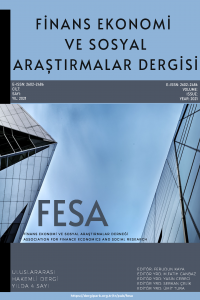Avrupa Birliğinde Marjinal Endüstri İçi Ticaret ve İş Gücü Uyum Maliyeti
Endüstri İçi Ticaret, Uluslararası Ticaret, İşi Gücü Uyum Maliyeti, Dinamik Panel Data
Marginal Intra-Industry Trade and Labor Adjustment Cost in EU
___
- ARELLANO, M., BOND, S. (1991). Some Tests of Specification for Panel Data: Monte Carlo Evidence and Application to Employment Equations. Review of Economic Studies 58: 277-297.
- ARELLANO, M., BOVER, O. (1995). Another Look at the Instrumental Variable Estimation of Error-Components Models. Journal of Econometrics 68: 29- 51.
- BALASSA, B. (1979). Tariff Reductions and Trade in Manufactures Among the Industrial Countries. American Economic Review 56: 466-473.
- BLUNDELL, R., BOND, S. (1998). Initial conditions and moment restrictions in dynamic panel data models. Journal of Economics 87: 115- 143.
- BLUNDELL, R., BOND, S. (2000). GMM estimation with persistent panel data: an application to production functions. Econometric Reviews 19: 321-340.
- BRÜLHART, M. (1994). Marginal Intra- Industry Trade: Measurement and Relevance for the Pattern of Industrial Adjustment. Weltwirtschaftliches Archiv 130(3): 600- 613.
- BRÜLHART, M., ELLIOT, R. (1998). Adjustment to the European Single Market: Inferences from Intra-Industry Trade Patterns. Journal of Economic Studies.
- BRÜLHART, M., MCALEESE, D. and O’ DONNELL, M. (1999). Ireland. In M. Brülhart and R. Hine (eds.). Intra-Industry Trade and Adjustment: The European Experience. London: Macmillan.
- DIXON, P., and MENON, J. (1997). Measures of Trade as Indicators of Factor Market Disruption. Economic Record 73 (September): 233- 237.
- GREENAWAY, D., HINE, R.C. (1991). Intra-industry specialization, trade expansion and adjustment in the European economic space. Journal of Common Market Studies 24: 603-22.
- GREENAWAY, D., HINE, R., MILNER, C. and ELLIOT, R. (1994). Adjustment and the Measurement of Marginal Intra- Industry Trade. Weltwirtschaftliches Archiv 130: 418- 427.
- HAMILTON, C., and KNIEST, P. (1991). Trade Liberalization, Structural Adjustment, and Intra-Industry Trade. Weltwirtschaftliches Archiv 127: 356- 367.
- KOL, J., and KUIJPERS, B. (1999). The Netherlands. In M. Brülhart and R. Hine (eds). Intra- Industry Trade and Adjustment: The European Experience. London: Macmillan.
- LOVELY, M.E., and NELSON, D.R.. (2000). Marginal Intra- Industry Trade and Labor Market Adjustment. Review of International Economics 8: 436- 447.
- LOVELY, M.E., and NELSON, D.R. (2002). Intra- Industry Trade as an Indicator of Labor Market Adjustment. Weltwirtschaftliches Archiv 138.
- MENON, J., and Dixon, P. (1997). Intra- Industry versus Inter- Industry Trade: Relevance for Adjustment Costs. Weltwirtschaftliches Archiv 133: 164- 169.
- PORTO, M., and Costa, F. (1999). Portugal. In M. Brülhart and R. Hine (eds.), Intra- Industry Trade and Adjustment: The European Experience. London: Macmillian.
- ROSSINI, G., and Burattoni, M. (1999). Italy. In M. Brülhart and R. Hine (eds), Intra- Industry Trade and Adjustment: The European Experience. London: Macmillan.
- SARRIS, A.H., PAPADIMITRIOU, P. and MAVROGIANNIS, A. (1999). Greece. In M. Brülhart and R. Hine (eds.), Intra-Industry Trade and Adjustment: The European Experience. London: Macmillian.
- SMEETS, H.D. (1999). Germany. In M. Brülhart and R. Hine (eds.), Intra- Industry Trade and Adjustment: The European Experience. London: Macmillian.
- THARAKAN, P.K.M., and CALFAT, G. (1999). Belgium. In M. Brülhart and R. Hine (eds.), Intra- Industry Trade and Adjustment: The European Experience. London: Macmillan.
- Yayın Aralığı: Yılda 4 Sayı
- Başlangıç: 2016
- Yayıncı: Ferudun KAYA
BORSA İSTANBUL’DA ENERJİ ŞİRKETLERİNİN NAKİT AKIM ORANLARINA DAYALI FİNANSAL PERFORMANS ANALİZİ
TÜRKİYE’DE KATILIM BANKACILIĞININ GELİŞİMİ VE KATILIM BANKACILIĞI SEKTÖRÜ SWOT ANALİZİ
Şenay Selin CAN, Mehmet İSLAMOGLU
TOPLUMSAL CİNSİYET EŞİTSİZLİĞİ EKSENİNDE COVID -19 ve KADIN YOKSULLUĞU
Berna AK BİNGÜL, Rengin AK, Armağan TÜRK
Gökçen AKYOL, Meltem BİLİRER, Feyyaz ZEREN
Avrupa Birliğinde Marjinal Endüstri İçi Ticaret ve İş Gücü Uyum Maliyeti
YÜKSEK ENFLASYONLU EKONOMİLERDE FİNANSAL RAPORLAMA KAPSAMINDA ÖZELLİK ARZ EDEN KONULAR
TÜRKİYE’ DE YABANCI PORTFÖY YATIRIMLARI VE CDS İLİŞKİSİ: 2008- 2021 DÖNEMİ İÇİN BİR İNCELEME
